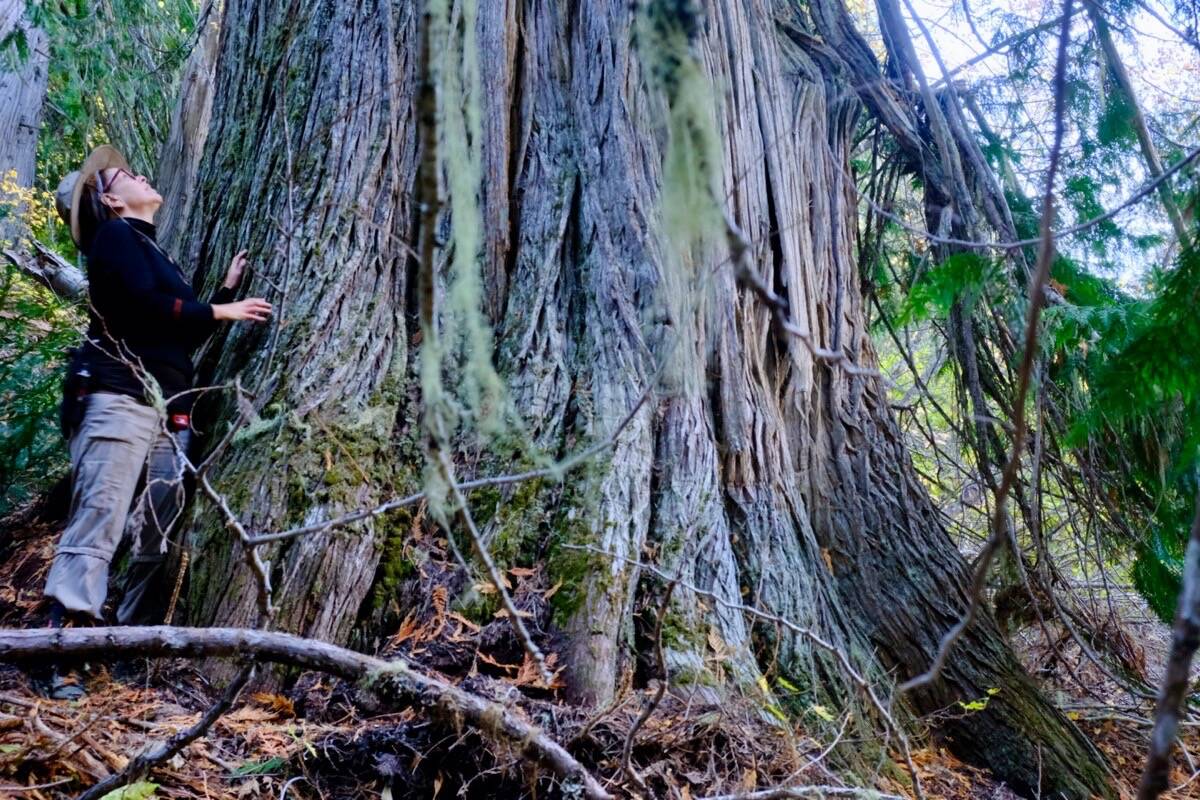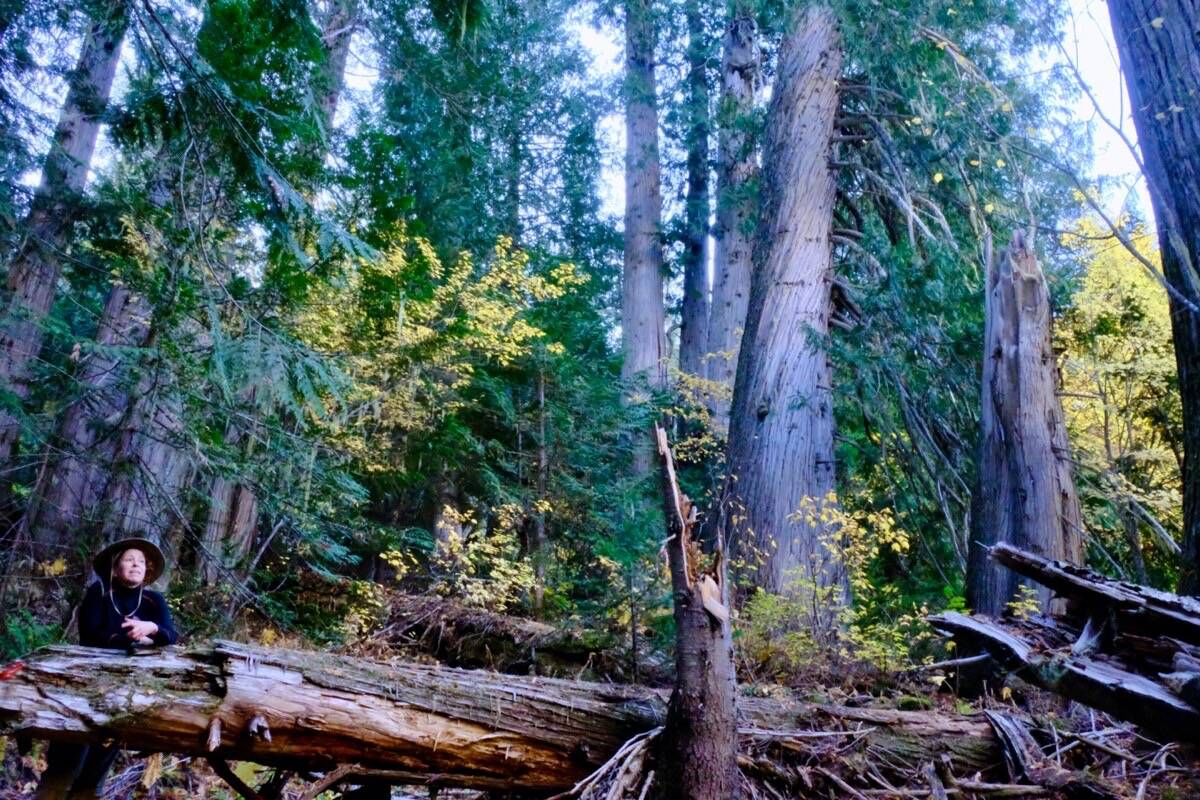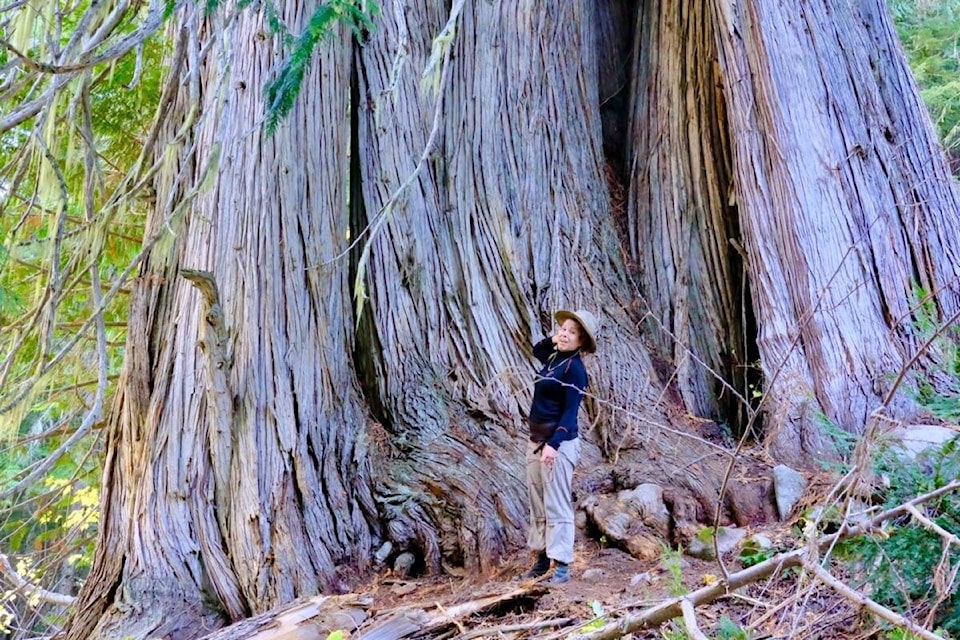Biologist Rosie Wijenberg feels right at home walking beneath the huge cedars in an old growth forest near Russell Creek in the West Kootenay.
She doesn’t seem too concerned about the waist-deep canopy of devil’s club as she wades through its huge leaves and heavily armed stems.
“I just kind of swim through the devil’s club,” she says. “I absolutely love this forest. You have good sight lines, it’s really nice and open, it’s beautiful.”
One of Wijenberg’s many contracts as a biologist is to measure and verify big trees in the Kootenays for the UBC . When she finds a big tree that has been nominated for the list, sometimes by a member of the public, she measures its diameter at chest height, then reports it to the program.
The list has about 600 trees on it, most them in the southwestern part of the province. The largest tree in the registry is known as the Cheewhat Giant, a western red cedar on the west coast of Vancouver Island.
There are three trees in the immediate Nelson area on the list, all of them western red cedars: one in the Giveout Creek area, one at Smallwood Creek, and the third by the Old Growth Trail near Kokanee Glacier Park.
Wijenberg’s favourite big tree in the Kootenays is a western red cedar known to some as the Duncan Mother at the north end of Duncan Lake. It’s the second largest cedar on record in the interior of B.C., she says.
“She’s just a beautiful tree. She’s on a flat, right by the river. Some age estimates have been 2,000-plus years for her.”
The registry does not have specific qualifying criteria, in terms of the diameter of the tree, because two trees of the same age and species will grow to different sizes, depending on whether they are in a valley bottom or at higher elevation, or at the coast or in the interior. A small tree can be older than a large one of the same species, depending on the geography.
No protection
Inclusion on the UBC list does not come with any form of protection from logging. A big tree on the list could be cut down tomorrow or next year, as long as it’s not in a park. Even if it grows in one of the provincial government’s areas, those deferrals are temporary.
Then what is the point of the list?
Ira Sutherland, who runs the program at UBC and is chair of its Big Tree Committee, says it’s about public information and conservation.
“The concern is that once we lose these trees, they’re likely gone forever,” he says.
He says the program helps the public understand old trees and advocate for their preservation.
“We’re getting out there and we’re forming relationships with these old growth forests,” he says. “And we’re creating stewards and guardians at the local scale.”

Wijenberg agrees that the point is simply to document the existence of the trees.
“Lots of times they disappear and nobody ever knows that they were there,” she says. “It’s also to advocate for change so that these trees get more protection.”
Provincial protection decided by timber companies
In 2020, the provincial government enacted the , stating it was designed to protect old trees. This regulation is about individual trees and is not connected to other laws or policies that might affect old growth forests.
There is no direct connection between the UBC Big Tree Registry and the new regulation. Sutherland says most of the trees on UBC’s list would not qualify for protection because of the regulation’s restrictive criteria.
Wijenberg says there is no role for the public in identifying trees to be covered by the province’s regulation.
The only person, according to the regulation, who may recommend a tree for preservation is anyone with an agreement under the Forest Act to log, plant trees, build roads or enhance wildlife habitat.
Sutherland says this means that identification of trees is done “in the context of logging operations.”
When a tree is accepted into the ministry list of protected big trees, a one-hectare buffer must be left around the tree (a radius of 56 metres).

Wijenberg says the regulation’s list of qualifying species is too restrictive.
The regulation lists 14 species that are eligible. She wonders why it is missing many others, including western hemlock, larch, alpine fir, and all pines except ponderosa.
The Ministry of Forests in an email told the Nelson Star that they narrowed down the species by choosing species that had at least 10 entries in the UBC Big Tree Registry.
The email stated that there are now 218 trees on the province’s protected list, and four of those are in the Kootenay Boundary region.
How big is big?
The provincial regulation contains a chart showing the diameter that a tree must have achieved before it is eligible for protection, for each of the 14 species. In some cases the regulation gives different measurements for the interior and the coast.
For example, a western red cedar with a diameter of more than 290 centimetres in the interior of B.C., or a Sitka spruce greater than 283 centimetres anywhere in the province, would be protected.
Those and the prescribed measurements for the rest of the 14 species are, according to Wijenberg, “laughable,” because they are too restrictive. They exclude too many trees.
Wijenberg says she has measured more than 20 trees in the Kootenays in the past two years for the UBC registry, and only three of those would qualify for protection under the provincial regulation.
She has never seen a Douglas-fir in the Kootenays larger than the 1.6-metre threshold in the regulation for the interior of the province.
“That diameter (specified in the regulation) needs to be brought down. To find a Douglas-fir of that size is incredibly rare.They have been logged to death here. And those big trees are under attack from Douglas-fir beetle.”
She says the 1.6-metre limit sends the message that the oldest or biggest Douglas-firs in the region are not worth protecting.
Sutherland agrees that many of the trees in UBC’s registry are not protected by the regulation because of the province’s strict size thresholds.
“It only gets us part of the way to where it should get to,” he says. “In reality, the regulation only protects the biggest of the big trees.”
The ministry may be re-thinking the diameter requirements.
In its response to the Star, the ministry said it initially estimated approximately 1,500 trees would be registered after five years.
“However, given the current number of registrations (218), we are re-examining the diameter thresholds using additional data and analyses.”
READ MORE:
•
•
bill.metcalfe@nelsonstar.com
Like us on and follow us on




